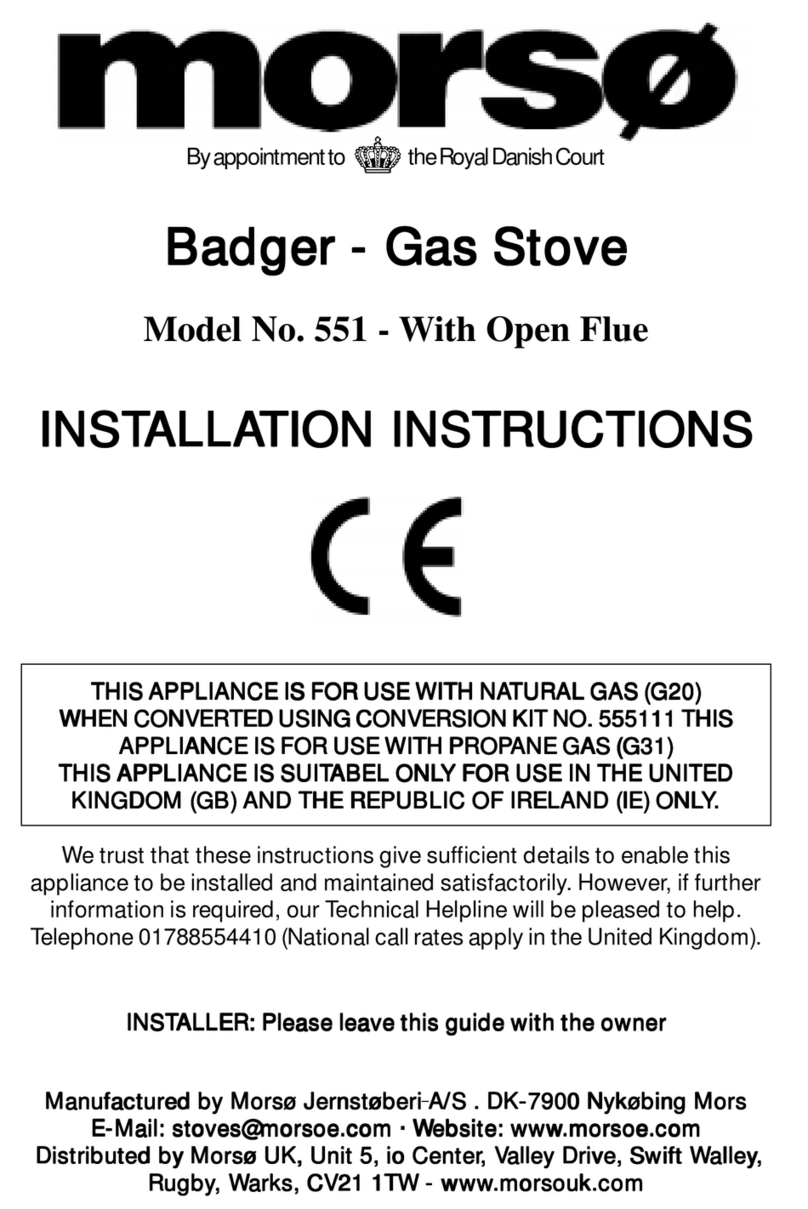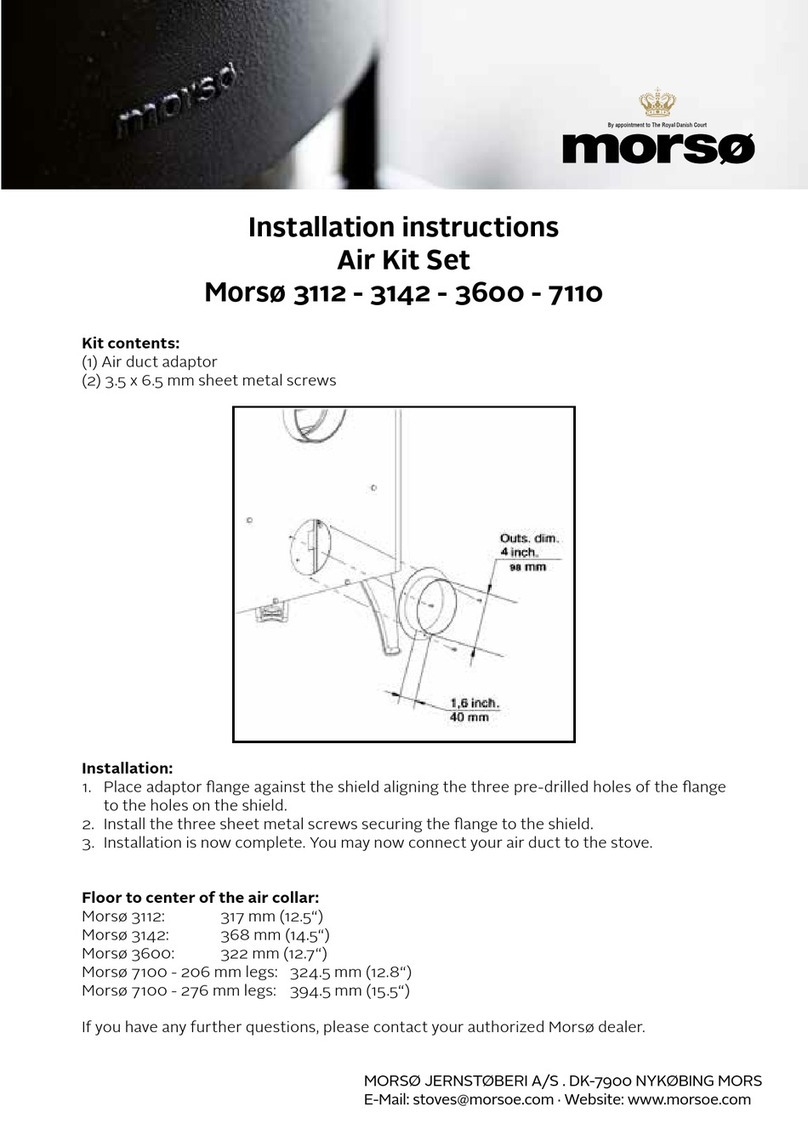Af hensyn til varmecirkulation, rengøring og evt. indvendig rensning af ovn, anbefales afstand
til murværk at være 10-15 cm. Et lag tapet bliver normalt, når det er påsat murværk, betragtet
som ikke-brændbart materiale.
På gulvet
Sker opstillingen på brændbart gulv, skal de nationale og lokale bestemmelser overholdes
med hensyn til størrelsen på et ikke brændbart underlag, der skal dække gulvet under ovnen.
Man bør naturligvis sikre sig, at underlaget kan bære ovnens og evt. stålskorstenens vægt.
Møbleringsafstand
Den anbefalede møbleringsafstand er 900 mm, men man bør dog vurdere, om møbler og an-
det vil blive udtørret af at stå tæt på ovnen.
Afstand til brændbart materiale foran ovnen er 900 mm.
En brændeovn bliver varm under fyring. Der skal derfor udvises en fornøden forsigtighed, spe-
cielt i.f.m. børns kontakt med ovnen.
1.5 Skorstenen
Hvis lokale bestemmelser tillader det, kan ovnen tilsluttes en skorsten, hvortil der i forvejen
er tilsluttet et andet lukket ildsted ( f.eks. en anden brændeovn eller oliefyr ). Men bemærk at
en brændeovn ikke må tilsluttes samme skorsten som nye kondenserende oliefyr. Er De i tvivl
bedes De kontakte Deres skorstensfejer.
Man skal være opmærksom på eventuelle krav til placering af røgrør, hvis to eller flere ildste-
der tilsluttes samme skorsten.
Brændeovnen må aldrig tilsluttes en skorsten, hvor et gasfyr er tilsluttet.
En moderne effektiv ovn stiller større krav til Deres skorsten. Lad derfor skorstensfejeren vur-
dere skorstenen.
Skorstenens lysning skal følge de nationale og lokale bestemmelser. Men generelt bør lys-
ningsarealet mindst være 175 cm2for brændeovne.
En for stor skorstenslysning bevirker, at der bruges for meget energi på at få opvarmet skor-
stenen til et acceptabelt træk. Er der tale om en muret skorsten med større lysning, anbefales
det at isætte en isolerende skorstensforing med den rigtige diameter. Herved opnås et forøget
træk og tillige en bedre fyringsøkonomi.
Der stilles ingen krav til nogen bestemt skorstenshøjde, men den skal være så høj, at trækfor-
holdene er i orden og røgen ikke generer. Som hovedregel er trækforholdene tilfredsstillen-
de, når skorstenen er 4 meter over ovnen og er ført mindst 80 cm over tagrygningen. Placeres
skorstenen ved husets sider bør toppen af skorstenen aldrig være lavere end husets tagryg el-
ler tagets højeste punkt. Bemærk, at der ofte gælder nationale og lokale bestemmelser med
hensyn til placering af skorstene i forbindelse med stråtag. Se afsnittet trækforhold 1.9.
Skorsten og røgrør skal forsynes med renselemme. Størrelsen på renselemme i skorsten skal
mindst svare til skorstenens lysningsareal.
Skorstenen skal være tilgængelig for udvendigt eftersyn, og der skal være mulighed for ad-
gang til renselemme og til skorstenen, hvis den skal renses fra toppen (eks. stålskorstene).
1.6 Rørtilslutning
Den øverste støbte topplade løftes af ovnen.
Bemærk den runde støbte dækplade i toppladen skal forblive fastmonteret, hvis ovnen skal
monteres med røgrør bagud og skrues af den øverste topplade, hvis røgrøret ønskes monte-
ret ovenud.
Montering af røgtud ovenud
Ovnen er fra fabrikken forberedt til montering af den vedlagte røgtud (1) ovenud med vedlagte
kuglefang og skruer. Kuglefanget, der skal forhindre at skorstensfejeren ødelægger ovnens-
røgledeplader under rensning, er den 145 mm lange stang, der er vedlagt.
Montering af røgtud bagud
Ønskes ovnen monteret med røgaf-
gang bagud, afmonteres den runde
plade, der er fikseret med 2 skruer
bag på ovnen. Pladejernsbrikken på
den indvendige konvektionsbagpla-
de slåes ud med små kontante slag
med en hammer ud for de små ”bro-
er”, der holder brikken på plads.Det
støbte dæksel fjernes fra bagpladen
og monteres på toppladen. Røgtuden
centreres og skrues fast på ovnens
bagside med de vedlagte lus og skru-
er. Kuglefanget skal ikke anvendes
ved montering af røgtud bagud.
Placering af røgledeplader
Røgledepladerne (2) og (3), der er
udført i vermiculite, er placeret ved
modtagelsen.
Man skal sikre sig, at røgledeplader-
ne er korrekt monteret inden en op-
tænding af ovnen finder sted. ( se
skitse )
1.7 Tilslutning til muret skorsten
I væggen fastmures en røgrørsbøsning, og røgrøret føres ind i denne. Røret må ikke stikkes
ind i selve skorstensåbningen, men kun gå til den indvendige side af skorstenslysningen. Sam-
lingerne ved ovn/rør og rør/murbøsning skal tætnes med den vedlagte glassnor. Normalt be-
høver man ikke tætne mellem evt. rørsamlinger.
Evt. overgang fra lodret til vandret røgrør kan med fordel monteres med en blød bøjning for at
undgå tab af skorstenstræk.
Dimensioneringen af røgrør skal følge de nationale og lokale bestemmelser. Morsø anbefaler
dog, at røgrør udføres i 2 mm stålplade, da det vil forlænge røgrørets levetid.



















































